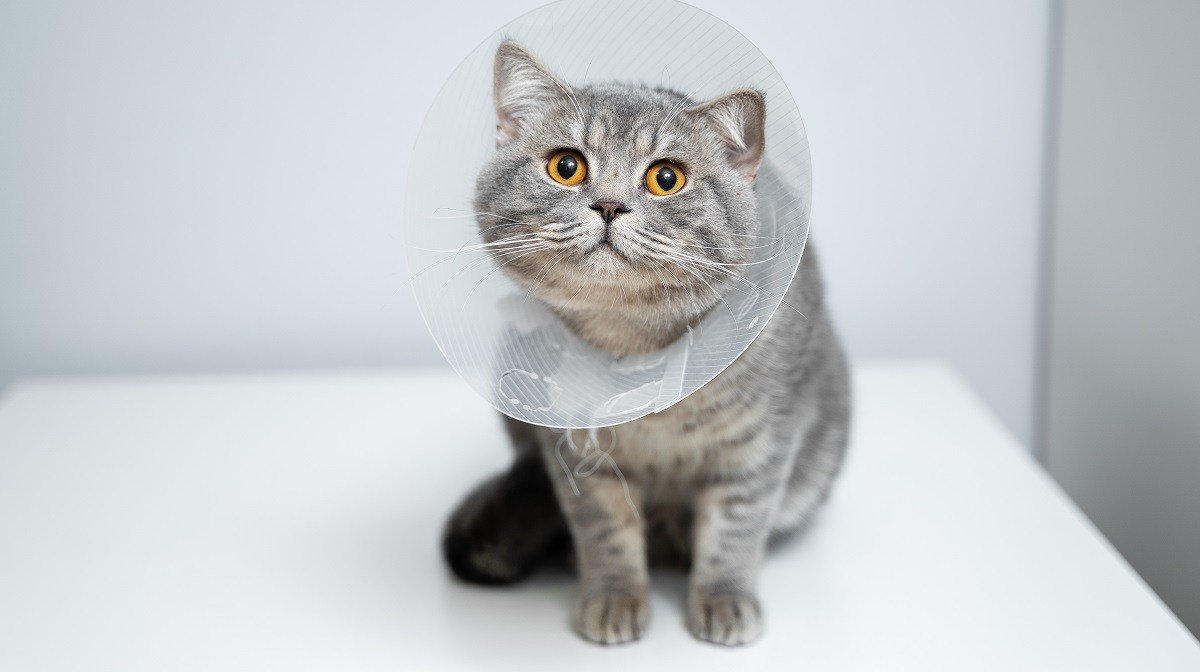
Frau aus UA / Shutterstock.com
A biopsy is a sample of cells or tissues from the body that is collected and evaluated to understand a disease process. Biopsies are conducted for both humans and pets, including cats.
If your veterinarian has recommended a biopsy for your pet, you may be nervous or unsure of what to expect. But understanding what a biopsy entails can help ease your nerves and prepare you and your cat for the procedure.
What Is a Biopsy?
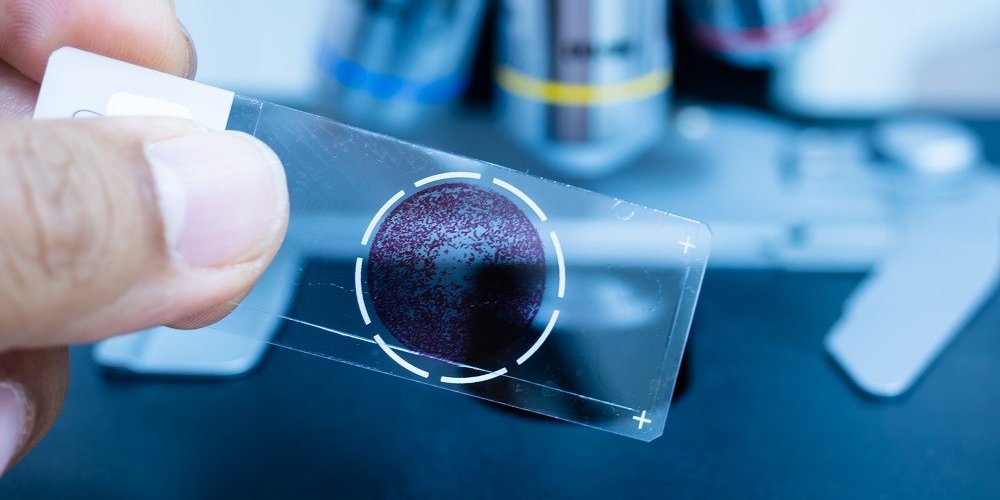
A biopsy is a collected sample of tissue or cells evaluated at a microscopic level. Konsam Loonprom / Shutterstock.com
Sometimes your vet can evaluate biopsy samples, but sometimes a veterinary pathologist is needed to use their more specific level of skill and knowledge to help a vet understand what type of process is occurring in the body.
Dr. Allison Gerras, a veterinary pathology resident at Michigan State University, describes her interest in feline pathology this way: “I just love looking at something grossly and then breaking it down to the cellular and molecular level to see what the cells are doing and how you can link that to the rest of the animal,” she said.[1]
Veterinarians need biopsies to arrive at a more specific answer to provide the correct treatment. “I love helping veterinarians and owners get answers and find out what’s going on with their pet,” Dr. Gerras said.”I enjoy being able to give them a prognosis, point them in the right direction so that the animal gets the best treatment they possibly can.”
When most people think of biopsies, they think of a piece of actual tissue being sampled. When a tissue sample is collected and sent out to be evaluated, this is called histopathology (histo–tissue, pathology–study of disease).[2]
However, as mentioned, a biopsy is a collection of cells or tissues from the body. According to this definition, a biopsy technically can include a collection of any kind of cells, including the collection of blood, which can be used for a multitude of testing types and can be referred to as a liquid biopsy.
A fine needle aspirate, a collection of only tissue cells from an area of concern using a small needle and syringe, can also be considered a biopsy under this definition.
In this article, we will be focusing mainly on tissue biopsies being sent out for histopathology. This will include situations where a tissue biopsy is most helpful, techniques involved for collecting tissue samples, the process involved, and what to expect.
Types of Tissue Biopsies
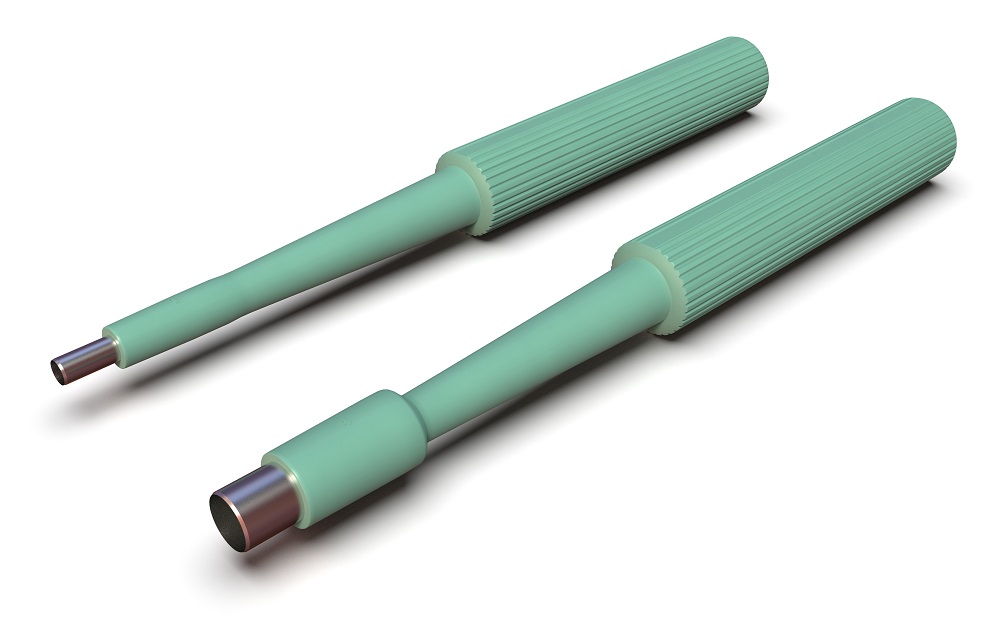
A biopsy punch is one tool a vet might use to collect a tissue biopsy sample. Peter Sobolev / Shutterstock.com
First, there are several categories of tissue biopsies that can be collected. These are categorized based on how much tissue is collected and how it is collected.
Incisional biopsy: An incisional biopsy involves collecting a small piece of tissue from a larger area. That area might be a mass or tumor, or it could be an organ, like the kidney, liver, or spleen.
Incisional biopsies are used mainly to either screen for disease (especially for an organ) or to determine what type of process is occurring with a larger mass or tumor. Getting a diagnosis through an incisional biopsy can help determine what treatment approach (such as using medication versus surgery) will provide the best outcome.
Incisional biopsies are often collected from an area using a scalpel or surgical scissors.
Needle biopsies: A fine needle aspiration biopsy is another type of incisional biopsy where a long biopsy needle instrument (such as a Tru-Cut) is used to collect a sample of tissue. These are most often used to collect biopsies from inside the abdomen either during abdominal surgery or through ultrasound guidance. [5]
A specialized biopsy tool involving a needle might also be used to collect bone marrow samples. Needle biopsies have a limitation in that they can be very long samples but they have a very narrow diameter. The largest is typically a 14-gauge needle size.
Excisional biopsy: An excisional biopsy usually involves the removal of an entire area of concern. For example, if your cat has an entire skin tumor or mass removed and sent out to a laboratory, this is an excisional biopsy.
With excisional biopsies, the goal is often looking for a cure for a condition, such as a tumor or growth, while also finding out more about it and if further treatment is needed.
Punch biopsy: A punch biopsy is a type of incisional or excisional biopsy using a biopsy punch. A biopsy punch is an instrument with a circular blade used to collect a small, circle-shaped piece of tissue.
Punch biopsies are most often used to diagnose skin conditions or skin masses but are sometimes used to collect small samples during surgery. Their limitation is that they have a small size, with the largest typically being 8 millimeters in diameter. For very small skin growths, a punch biopsy might be used to collect an excisional biopsy by removing the whole mass for evaluation.[6]
Tissue Biopsy Vs. Fine Needle Aspirate
This is a common point of confusion for pet parents after seeing their veterinarian collect a sample of a growth or mass using a needle and syringe.
A fine needle aspirate is a procedure using a small needle and syringe to aspirate, or suck up, cells from a location of concern.
Fine needle aspirates, or FNAs, are often a first step to evaluating a growth. They are less invasive than a tissue biopsy and often do not require any sedation or anesthesia to perform.
When a FNA sample is collected and evaluated, this is called a [3]cytology (“cyt” means cells and “ology” means study of).
While these are common to collect, their downside is that they might have less accuracy compared to a tissue biopsy.
Preparing for a Biopsy Procedure
The prep needed for a biopsy procedure depends on how invasive the procedure is and what type of procedure is required. If only a local block is needed, there might be no need for prep at all since the cat is awake during the whole procedure. It’s still important to follow your vet’s instructions, as you might need to drop your cat off for a couple of hours for the procedure.
If sedation is needed, bloodwork might or might not be required. This might depend on how short the biopsy procedure is expected to be and what area is being sampled. Your veterinarian might provide instructions not to allow your cat to eat or drink for 12 to 24 hours prior.
When anesthesia is required, a full blood test is often required prior. Your vet needs to know if proceeding with anesthesia is safe. Fasting for 24 hours is also very standard prior to any anesthetic procedure.
In addition to regular lab work, an additional panel to check the body’s ability to clot blood properly might also be required. Complications like bleeding are possible. This is especially true if the liver is being biopsied.
Once any prior testing has been completed and your cat has been cleared, follow your vet office’s instructions for when to arrive with your cat on the day of the procedure.
The Biopsy Procedure
The type of procedure required for a biopsy might differ depending on the type of tissue sample that is needed. Because collecting a tissue biopsy requires cutting actual tissue out, it’s necessary that a cat can’t feel this happening.
Three different types of procedures may be used to collect a tissue biopsy. Your veterinarian will understand best which approach will be needed.
Local Anesthetic
A local anesthetic is an injectable medication that numbs a small area around the injection site. Examples include lidocaine and bupivacaine. Local anesthetic, or a “local block,” can be used to perform a biopsy procedure.
Advantages include:
- Lower procedure cost
- Eliminates risk of sedation or anesthesia
But there are limitations as well, including:
- The biopsy site must be on the skin (biopsying something inside the body cannot be performed this way)
- The mass being biopsied or the biopsy site must be very small (usually a centimeter or less in diameter)
- A cat must be extremely calm, easy to handle, and remain still
Sedation
Sedation is a step down from full anesthesia. With sedation, a sedative medication is injected that makes the cat very tired and less reactive, but not fully asleep. Local anesthetic might be used in conjunction with sedation.
Advantages of sedation include:
- Relieving stress of restraint/handling for the procedure
- Procedure cost is still lower than an anesthetic procedure
- A slightly larger area may be sampled or tissue removed compared to only using local block
Disadvantages include:
- Sedation might have less risk than anesthesia but still carries some medication-related risks
- Biopsy site limitations (typically, only areas on the skin can be sampled)
General Anesthesia
Although understandably scary to some pet parents, general anesthesia is required for some procedures, including some types of biopsies. Generally, anytime a larger mass or growth on the skin requires surgical removal, anesthesia will be required. This also goes for any procedure in the abdomen.
Advantages include:
- No pain or discomfort during the procedure
- Allows for more invasive biopsy sites like in the chest or abdomen and mouth
- Allows for larger biopsy samples (including entire masses or growths being removed surgically)
Disadvantages include:
- Anesthetic risk
- Bloodwork is often required prior to anesthesia
- Anesthetic procedures carry the highest cost for biopsies
What to Expect After a Biopsy
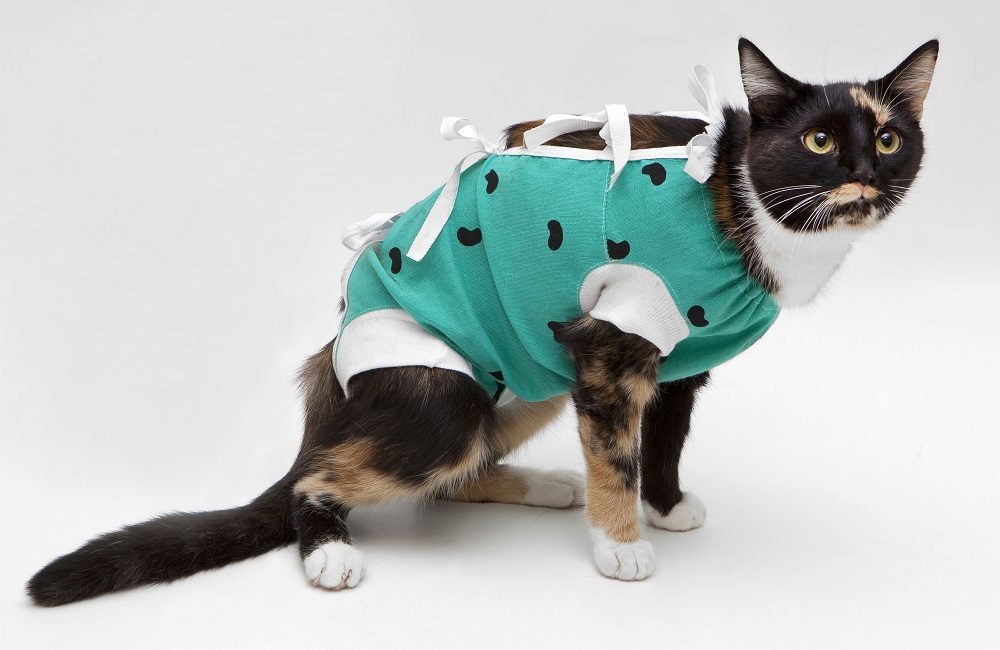
After some biopsy procedures, an Elizabeth collar or a onesie-type outfit may be required to protect a healing incision. gorra / Shutterstock.com
Healing
The time for healing will depend on the type of procedure performed and how large a tissue sample is needed. Below, the healing process is described for various biopsy procedure types.
Ultrasound-guided needle biopsy (such as with a [5]Tru-Cut): The biopsy site will heal very well on its own. The period of anesthesia is typically very short for this type of biopsy procedure, often less than an hour. Most cats will recover quickly.
It might take up to 24 hours for signs of anesthesia to fully wear off, assuming all else is normal. After any hospital procedure, it can be common for a cat to hide and not be social for a day or two. On the flip side, some cats might be more needy and clingy, preferring to be with you more than normal.
In either case, ensure that other normal necessities are occurring, such as coming out to eat and drink and using the litter box.
A follow-up call, email, or text from your vet’s office the day after an anesthetic procedure is common. But if you have any concerns 24 hours after the procedure, contact them.
Growth Removal or Abdominal Surgery: With any surgery involving a larger incision greater than a centimeter, instructions should be sent home for careful monitoring for the next 10 to 14 days. This is the time it takes for the skin to heal. Either an Elizabethan collar (cone) or a onesie type of outfit might be required to protect an incision from licking, biting, or scratching.
Keep your cat rested and often confined to a smaller room, like a small bedroom or bathroom, to keep them from running around and jumping on and off furniture.
Sedated Procedure: Recovery from sedation is typically shorter than from anesthesia. In many cases, an hour or two is all that is required but some cats might still exhibit some behavioral changes for several hours afterwards.
Punch Biopsy: This may be performed either under sedation or anesthesia, depending on location, number of biopsies, and other factors. The sample size for punch biopsies is very small, so the time it takes to heal is often shorter than with larger growth removals or abdominal surgery. It might only take up to a week for these small areas to heal.
Getting Your Cat’s Biopsy Results
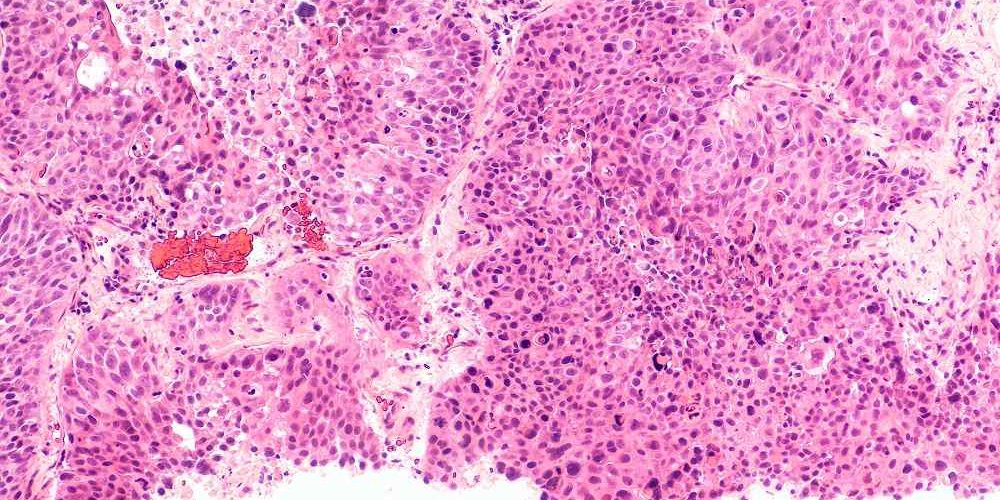
Once prepared by a pathologist, this is how a biopsy sample looks under a microscope. David A Litman / Shutterstock.com
Getting histopathology results from a tissue biopsy often takes about a week. It can be difficult being patient for such a long time in an age when we’re used to getting information so immediately, but tissue samples take time to process.
When a pathologist obtains a sample, the tissue itself must be prepared and sectioned into thin pieces down to a single layer of cells so the pathologist can look at them under a microscope.[4]
Biopsies of bone can take longer than a week as all of the minerals must first be removed before the tissue can be further processed. It is not uncommon for these biopsy results to take two or even three weeks.
When the results do come back, your vet will receive a report from the pathologist who processed and reviewed the sample. The biopsy report is often very technical. When they contact you, your vet acts as a kind of translator for the information. The most important details that your vet will relay to you include:
- What type of process is going on? (inflammation, infection, cancer, etc)
- If the tissue is from a mass, is this mass malignant (cancerous) or benign?
- If the tissue is from a mass, was the mass removed with complete margins (did all borders of the sample include at least a thin border of normal tissue indicating that the mass was fully removed)?
What a histopathology report does not tell you is what steps to take with the information. When discussing the report with you, your vet will provide next-step recommendations.
This might mean treatment with medication, a surgical procedure, or referral to a veterinary specialist. For example, referral to a veterinary oncologist is very common when a biopsy report indicates that a mass or tumor is a malignant form of cancer and that further specialized treatment would be needed.
Frequently Asked Questions
How much does a biopsy cost for a cat?
The cost for histopathology (tissue biopsy results) themselves might vary between hospitals and regions of the country. A cost of $200 to $300 is very common.
But there are other costs involved including the biopsy procedure and the costs of either local anesthesia, sedation, or general anesthesia. At the low end with just local anesthesia, the cost might start around $250 to $300. But if a surgical biopsy under general anesthesia is required, this cost might easily exceed $1,000 to $2,000, depending on your area and the complexity of the procedure.
Why would a vet do a biopsy?
The main purpose of any biopsy is to try to determine a diagnosis for a disease condition using fluid or tissue samples. A tissue biopsy might be used to diagnose a tumor or mass, a non-healing skin condition, or the type of disease process occuring in an organ, like the liver.
How much does an endoscopic biopsy cost for a cat?
An endoscopic biopsy is a very specialized procedure most often performed by an internal medicine specialist or surgical specialist where a tiny camera on the end of a long tube called an endoscope is inserted into the GI tract, respiratory tract, or through a small surgical incision. An endoscopy procedure must always be performed under general anesthesia. This procedure commonly costs a couple of thousand dollars owing to the complexity and skill required.
Is a biopsy a serious procedure?
This can depend greatly on how advanced a biopsy procedure is. A small skin biopsy using a biopsy punch with local anesthesia or sedation might only take 10 to 15 minutes with limited risk.
Some tissue biopsies might need to be collected under anesthesia or through a surgical procedure. Depending on a patient’s age and health condition, this could be considered a more serious procedure.
A veterinarian will look to work with you to understand the benefits of collecting a tissue biopsy sample and sending it out for analysis along with the risks of the procedure needed to collect the sample.
-
Chapin, C. (2023). Veterinary Pathology from Two Points of View: A Senior Pathologist and Resident Share Their Perspectives. Insights. Retrieved November 16, 2023,.
-
Cruz-Rincon, S., & Freeman, K. (n.d.). Histopathology in Pets. Veterinary Partner. Retrieved January 25, 2021.
-
Llera, R., Stoewen, D., & Rest, J. (n.d.). Cytology, Biopsy, and Histopathology. VCA Animal Hospitals. Retrieved November 16, 2023.
-
Parry, N. (2020, June 23). Could You Be a Veterinary Pathologist? The Pathologist. Retrieved November 16, 2023.
-
Tru-Cut Biopsy Device. (n.d.). Merit Medical. Retrieved November 16, 2023.
-
Williams, K., Hunter, T., & Ward, E. (n.d.). Skin Biopsy in Cats. VCA Animal Hospitals. Retrieved November 16, 2023.







